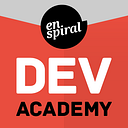How to turn Cyborg: Week 1
My adventures through Dev Academy’s web development programme
Dev Academy’s Marketing Manager Maddy King has taken it upon herself to brave the Dev Academy web development programme, and share her #nofilter thoughts on the journey.
I signed up to do the Dev Academy programme for three reasons. Firstly, I have ideas for apps and businesses that involve tech components, and I don’t want to have to pay someone else to build prototype for me to test whether the ideas have market appeal. I want to learn the skills to be able to build and test ideas myself. Secondly, I market web development so I know the benefits of this skillset. I know the lifestyle it can gain a person and the breadth of opportunities it opens up. Thirdly, I am sick of there being not enough women and other non-men in tech. If I can learn these skills — and that’s a big if — I would like to be part of changing that. It’s a type of thinking and a way of logic that’s unfamiliar to me. I want to prove to myself that I can do it.
So I began.
During my first week of Phase 0, the remote preparation phase, I was away with my parents who I hadn’t seen in 6 months. I was also working remotely on marketing part-time and had just been offered an adjacent business opportunity that required some background work. So I was very stretched for time and hanging out with my parents was my priority.
In saying that I still managed to get through the first sprint. I had a skype meeting with half my ‘cohort’ — the other people starting the course at the same time. This was great as I was able to gain a sense of what the other people were like and where they were at, and what their motivations were for joining the programme.
Most of the first sprint was about downloading and getting familiar with the tools. These included things like using the command line (the Terminal programme found in a computer’s applications, which gives a user direct access to ‘talk’ to the computer) to communicate with Github, the online cloud service where developers store all their code. I’d done a RailsGirls weekend in Wellington (which I highly recommend) that had introduced me to these concepts, so I understood vaguely why we were doing what we were doing, but some of the nitty gritty stuff took a while to get the hang of. It was really cool though, to start the week baffled and end the week using commands to download (“pull”) code from Github, modify it and re-upload (“push”) it without leaving the terminal window.
The assignments were communicated to us through a combination of explanatory pages posted on Github, and checklist-style tasks on Waffle, which is a task manager that’s a bit like Trello. This took a while to get used to, well I’m still getting used to it, as I never knew if I was missing explanations on Github when I found something tricky on Waffle. We also use a time tracker to see how much time tasks are taking us. And a text editor for writing the code — I use Atom.
There was also some reading and learning about the culture of Dev Academy and the expectations of the curriculum. I was familiar with this content through my work for Dev Academy.
I’d learned a bit of HTML and CSS through codecademy.com courses in the past in order to enhance my ability as a marketer. About our learning this week, I wrote-
“We’re essentially building a webpage like a person. HTML is the bones. In your HTML you have to designate your head, body and foot(er), and the different images and words etc. that you want in each section. You can then divide each section into further sections using divs (divisions) to designate more specific design features, like your ribs or your hips. All of these eventually make up the different parts that you see on a webpage.
CSS is the decoration. Once you’ve got your bones mapped out with HTML, you use CSS to decorate the body. What height, nose size, eye colour? Or, for your webpage, what background colour, font, text size? You might want to keep some of these essential features the same throughout your site, but change the clothing or shirt colour — the font size or image placements — in specific webpages. So we keep all the decoration instructions in their own document, called CSS. This lets us apply the same style to most of the webpages of a site, and make specific stylistic changes where we want them.”
So I was excited to start handcoding my first webpage of the programme in week 1 — that was fun. It was nice getting back into styling and elements. We had to build our own page and write some reflections on our first week. By the end of the first week of remote learning I built this (screenshot of a LIVE website):
Coding something from scratch, rather than using Wordpress or a template, has its own satisfaction that’s really cool, even if it looks average. But it wasn’t about building the page or making it look pretty, it was about getting into a workflow, understanding Github, and learning the easy commands to get the command line to help you with your work. All of this was pretty enjoyable.
Phase 0
Week: 1
Sprint: 1
Time logged: 7.5 hours
If you think you can handle the challenge, take the leap! Join Dev Academy and gain the skills to design a creative, flexible, well-paid lifestyle you love. Apply today and you could be graduating by May 2018.

